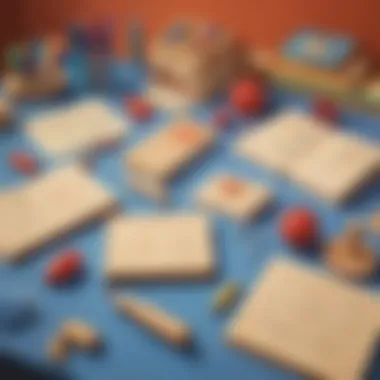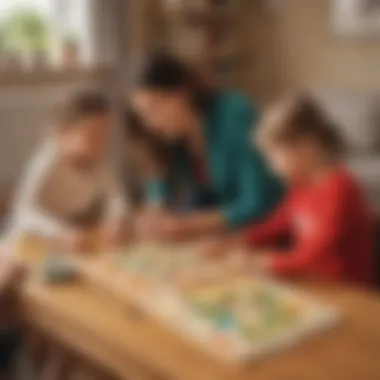Understanding the Shape Game: A Deep Dive into Learning


Intro
The concept of the shape game serves as a crucial educational tool in the early years of child development. Its significance extends beyond familiarity with geometric shapes; it presents an intricate awarness of spatial relationships. From classrooms to playgrounds, this playful approach enables children to grasp basic concepts of geometry, fosters analytical thinking, and cultivates creativity through hands-on engagement with their environment.
By understanding the layers that contribute to the effectiveness of the shape game, parents and educators can better implement it in everyday activities. The aim is to create an enriching atmosphere where children connect geometric patterns with their surroundings, resulting in a more substantial learning experience.
Creative Activities
Engaging children in creative activities centered around shapes offers immensely valuable educational experiences. Through exploration and creativity, kids enhance their cognitive abilities. Crafting offers a tangible medium through which they can learn about shapes in a systematic yet enjoyable way.
Craft Ideas
- Shape Collage: Using cut-outs of various colors and sizes, children can create vibrant collages. This activity reinforces the recognition of different shapes while encouraging creativity.
- Shape Masks: Children can design masks made from cardstock. They can incorporate multiple shapes, learning properties while enjoying a playful incorrugaration of design.
- 3D Structures: Building with blocks or clay shapes helps visualize three-dimensional objects, thus enhancing spatial reasoning.
Step-by-Step Guides
- Starting with the Collage: Gather magazines or colored paper and help children cut out different shapes.
- Creating Masks: Draw templates on paper for circular, triangular, or square masks. Allow children to explore decorating their chosen shapes with colors or designs.
- Constructing 3D Models: Provide basic materials and let children form various shapes, guiding them in developing structures or homes.
Educational Value
Engaging with these activities encourages motor skills enhancement and fosters problem-solving abilities. In terms of cognitive development, children practice identifying and categorizing shapes systematically. The integration of hands-on techniques promotes a healthy balance between play and informative experiences.
Fun Quizzes
Quizzes serve as a reinforcement tool for concepts related to shapes, sharpening children's understanding. They can enhance learning through both thought-provoking questions and pleasurable interaction.
Quiz Topics
- Basic shapes and their characteristics
- Identifying 2D vs 3D shapes
- Real-world applications of shapes
Question Types
- Multiple Choice: Engaging options encourage children to think about their choices.
- Fill-in-the-Blank: Questions requiring kids to recall information strengthen memory retention.
- Image Identification: Children recognize shapes by associating visual stimuli with the concept.
Knowledge Reinforcement
By participating in quizzes, children gain self-assurance in their grasp of shape-related topics. Positive reinforcement through fun, engaging activities inspires continued interest in geometry and spatial reasoning.
Fact-Based Articles
Reading factual articles cultivates curiosity and passion in children, allowing them to delve deeper into subjects surrounding shapes.
Topics
The breadth of topics can range from geometric history to practical uses in daily life. Moreover, engaging articles inform young readers about alphabets’ shape connections and basic architectural principles.
Engaging Content
Information is crafted to be straightforward yet stimulating. Layman's terms foster thorough comprehension without overwhelming younger readers, and visuals capture their attention.
Prelude to the Shape Game
Importance of the Topic
The Shape Game offers a window into educational practices focused on shapes, which are fundamental to early learning. Shape recognition develops basic math skills, enhancing children's ability to categorize, analyze, and solve problems. Introducing this game at a young age provides necessary scaffolding for critical thinking. Understanding its educational value is essential for parents, educators, and caregivers, as they are pivotal in fostering cognitive growth.


Definition and Purpose
The Shape Game is conceived as an engaging activity aimed at helping young learners identify and understand various geometric forms. Purpose driven, it establishes foundational cognitive skills that children carry with them into future learning experiences. Children encounter shapes in daily life, and this game encapsulates that relevance, making shapes come alive. It functions both as an educational tool and as a medium for exploration, providing opportunities for kinesthetic learning.
History and Development
The history of the Shape Game traces back several decades, evolving alongside educational theories and practices. Despite its seemingly simplistic premise, the game has undergone significant transformation. Initially, the game focused on rote memorization of shapes and their names, a model familiar across numerous classrooms. As educational principles shifted towards experiential learning, the Shape Game evolved to emphasize interactive and cooperative elements. Educators using advancements in psychology and cognition devised methods that spurred creativity and engagement. Through play, children now not only learn to recognize shapes but also understand their properties and relationships.
Educational Importance of Shapes
Shapes are not just part of geometry or art; they play a crucial role in early childhood education. In this article, we explore why focusing on shapes is significant for children. Understanding shapes is foundational for not only mathematical skills but also for cognitive and spatial development essential for various aspects of learning.
Cognitive Development Benefits
Research shows that engaging with shapes can significantly enhance cognitive development. Children actively learning shapes can improve their ability to categorize and analyze objects. This enhances skills such as recognition and memorization. When kids identify and differentiate between different shapes, their brain practices forming connections and processing visual information.
Moreover, manipulating physical shapes through activities such as puzzles or blocks encourages hands-on learning. These experiences help children develop fine motor skills, which are also essential in further academic tasks such as writing or art.
Enhancing Spatial Awareness
Shapes directly influence a child’s understanding of spatial relationships. This is the ability to think about objects in relation to one another in a given space. Recognizing shapes and their characteristics helps to build a foundation for future studies in areas like geometry and architectural design. Educators can leverage shape-based activities to promote this awareness.
Engagement with shapes aids children in learning concepts such as resizing, rotating, or translating shapes. These actions help them learn how objects interact in their environment. Thus, further strengthening their spatial reasoning. Having strong spatial awareness allows children to connect dots between subjects, encouraging interdisciplinary learning.
Facilitating Problem-Solving Skills
In game-based learning environments, shapes can prompt problem-solving skills in children. Whether during a structured game or free play, children encounter challenges that prompt them to think critically. For instance, figuring out how to fit different shapes into a sequence or matching shapes can foster a logical mindset.
Through trial and error, kids make assessments on how shapes can combine or discount possibilities. This exercise in decision-making is vital as children move through real-world experiences. It cultivates versatility in thinking, paving the way for complex problem-solving scenarios in their academic futures.
Engaging children with shapes provides a multi-faceted framework for learning where logic and creativity can intersect. Shapes evoke inquiry, exploration, and expression.
Overall, the educational importance of learning about shapes transcends basic identification. Instructing children on shapes nurtures essential skills that benefit their growth in multiple disciplines, laying strong groundwork for future learning.
Mechanics of the Shape Game
The mechanics of the shape game present an essential foundation for understanding its educational significance. This facet goes beyond mere play; it involves carefully structured sequences, rules, and dynamics that engage children cognitively and physically. When children interact with shapes, they enhance their learning experience by integrating play with recognition, naming, and applying various shapes in real contexts. The mechanics directly contribute to cognitive development, spatial reasoning, and problem-solving abilities, making it crucial for educators and parents to embrace this game in different learning environments.
How to Play
Playing the shape game is intuitive yet can be tailored to various educational levels. Here are some starting points that help childredn connect with shapes:
- Materials Needed: Collect common items such as paper shapes, blocks shaped like circles, triangles, squares, and other similar objects.
- Setting Up the Game:
- Traditional Game: Decide if players work individually or in teams.
- Objective: Recognize and categorize the shapes correctly.
- Alternatives Game Play: For younger children, you might also ask them to describe shapes using simple attributes like
The Role of Shapes in Education
The integration of shapes into education holds immense relevance. Shapes are much more than mere geometric figures; they are foundational elements in the learning journey of children. Their importance extends across various disciplines, particularly in early childhood education and mathematics. This section will unfurl the significance of shapes, their application in early learning, and their links to mathematical understanding.
Shapes in Early Learning
Shapes act as building blocks for early learning. They serve as tools through which young children can develop essential skills in a playful environment. First, kids can categorize shapes by attributes such as size, color, and type, aiding the enhancement of observation skills. This process includes recognizing circles, triangles, squares, and more, which scaffolds information retention for future learning tasks.
Another advantage is the improvement of hand-eye coordination. Playing with shapes facilitates fine motor skill development. Children engage in manipulative tasks with geometric blocks, puzzles, and other related materials, simultaneously having fun and learning.
Moreover, discussions about shapes propel language development. When children describe shapes, identify them, and categorize them, they learn new vocabulary and terms. Speaking about the characteristics of a shape encourages expressive communication and social interaction. These collaborative experiences can lead to deep learning connections and kickstart comprehensive language acquisition.


Shapes and Mathematics
Understanding shapes greatly contributes to mathematical proficiency. Shapes offer a concrete experience that bridges into abstract mathematical concepts. Early exposure to basics like symmetry, angles, and congruency lays a solid groundwork for advanced mathematical reasoning. Engaging with shapes in various contexts helps children understand balance in spatial reasoning, which is essential for geometry.
It is worth mentioning that learning shapes primes students for future math lessons. Questions surrounding perimeter, area, and volume naturally stem from shape exploration. Such inquiries instill logical thinking skills. Therefore, relationships between different shapes can reveal essential properties and patterns found in mathematics — a cornerstone of critical thinking.
Learning shapes is not merely an art; it directly influences mathematical expertise and critical reasoning skills.
Ultimately, shapes have a substantial role in education. Their practical ramifications and benefits impact cognitive development profoundly. Whether in early learning or more advanced mathematics, engaging with shapes prepares children for success in academia and future endeavors.
Implementing the Shape Game in the Classroom
The integration of the Shape Game into the classroom environment presents significant advantages for both educators and students. A practical application not only enhances learning but also makes abstract concepts, like shapes, tangible and relatable for young learners. Utilizing games such as this fosters engagement and motivates students, leading to a more interactive educational experience.
Integrating with Curriculum
Successfully integrating the Shape Game into the curriculum requires careful planning and consideration. This game can serve as an effective tool in teaching various subjects, particularly mathematics and art. In mathematics, teachers can utilize the game to illustrate basic concepts of geometry. Students can identify, draw, and manipulate different shapes, solidifying their understanding of perpendicular lines, angles, and symmetry.
Furthermore, the Shape Game can be aligned with lessons on spatial intelligence, a key component of cognitive development. For instance, educators can create lesson plans that encourage students to associate geometric shapes with real-world objects, such as buildings and vehicles. Activities might include constructing models or creating art projects that utilize specific shapes.
Involving the Shape Game in literacy can also enhance vocabulary development. Words related to shapes, like 'rectangle' or 'hexagon,' can not only be introduced but used in sentences during interactive play.
Assessment and Outcomes
Assessment in the context of the Shape Game has various facets, from observational techniques to systematic evaluation methods. Teachers can assess student understanding through informal means such as observation during play. Observing how students interact with shapes can inform educators about their level of comprehension. For example, if a child can successfully arrange a variety of shapes to create a cohesive picture or structure, this shows a solid grasp of spatial relationships.
Formal assessments can also be designed to measure knowledge gain and application. This could include worksheets where offsprings demonstrate shape identification or even combine multiple shapes to create something new, inviting creativity while evaluating their understanding. By tracking progress before and after the incorporation of the Shape Game, educators can derive clear insights into students' developmental achievements.
Ultimately, combining the Shape Game with educational objectives enhances not only academic but also social and emotional skills. It summons children to work cooperatively, communicate their ideas, and reason through challenges collectively. In this way, the implementations create adaptive learning positions that are as beneficial for cognitive growth as they are for lifestyle skills.
The Shape Game strengthens classroom dynamics, increasingly bridging education with fun and effective learning processes that endure well behind the classroom walls.
Playing the Shape Game at Home
Playing the shape game at home offers not only fun but also important educational benefits. Engaging with shapes helps children to relate what they learn in school with their daily lives. It reinforces concepts in a playful way and encourages creativity. Parents and caregivers can create an environment conducive to learning, making use of common objects found in the home to inspire recognition of shapes in context. By implementing shape-related activities, they can enhance their child's cognitive abilities and spatial understanding.
Creativity and Learning
The integration of shapes into creative play can ignite a child’s imagination. When players work with shapes, they often move beyond simple recognition. they can experiment with constructing, arranging, and modifying shapes using various materials. This not only expands their creative thinking but nurtures fine motor skills as they manipulate different objects. Children can draw shapes, cut out construction paper, or even build with blocks, merging artistic expression with logical reasoning.
Projects may include:
- Crafting collages from colored paper forms.
- Building structures from geometric blocks.
- Painting or drawing shapes in various sizes and colors.
This hands-on approach encourages experimentation. It allows children to explore spatial relationships and understand how shapes fit together or stand apart. The act of creating reinforces their understanding of geometric principles in action while producing tangible outcomes.
Family Engagement and Bonding
Playing the shape game can also be an avenue for families to spend quality time together. Engaging in group activities where everyone can contribute adds a social component to the learning process. Parent-child or sibling interactions around shapes encourage discussions about sizes, colors, and functions of different shapes.
Activities may include:
- A family game night with shape-themed games
- Outings where nature provides a canvas for shapes, like leaves and stones.
- Cooking projects where shape forms are present, like cookie cutters.
These shared experiences promote bonding while cementing the knowledge and skills derived from such activities. Everyday situations become learning scenarios. Additionally, this level of engagement gives parents insightful feedback about their child’s learning preferences and abilities. Strengthening these familial connections results not just in effective learning but creating memories that last.


Playing the shape game at home transforms routine ideas of learning into joyful experiences that foster creativity and strengthen relationships.”
Technology and the Shape Game
The integration of technology into education has transformed the way young learners engage with concepts. In the context of the shape game, technology offers unique avenues for exploration and play. The utilization of digital tools encourages interaction and motivations for students to learn about shapes.
Digital platforms can provide engaging environments for children. They foster creativity, logical reasoning, and problem-solving skills which are crucial in early education. Parents and educators should consider how these tools can complement traditional learning methods, making it more dynamic. Integrating technology allows children to explore shapes in diverse formats, leading to a richer understanding.
"In today's technology-driven world, adapting educational strategies to include digital tools is not just beneficial; it’s essential."
Digital Variants of the Game
The landscape of educational games has evolved significantly with the advent of technology. Many developers have embraced this by creating digital variants of shape games. Online platforms and apps focus on interactive play, encouraging children to discover shapes through puzzles and animations.
These digital variants can vary widely from drawing tools that let children construct shapes creatively, to apps that feature extensive mini-games concentration surround shapes. The flexibility and accessibility of these formats make shape learning engaging. Notable applications such as Shapes by Knowhere and Endless Alphabet enable children to explore shapes regularly, integrating knowledge of geometry seamlessly into their play.
The Impact of App-Based Learning
Learning applications provide opportunities for enhanced engagement in children’s educational journeys. App-based learning supports various styles to inform each child’s experience with shapes. Unlike static forms of education, these apps engage learners through visual stimulation. Children can tap, drag, and manipulate shapes in response to dynamic feedback.
Important influences of app-based learning include:
- Self-Paced Learning: Children can learn at their tempo. They don’t feel rushed, enabling them to fully engage with the material.
- Interactive Feedback: Many apps provide feedback loops which affirm a child’s progress or guide them towards the correct response.
- Multi-Sensory Learning: Colorful visuals combined with sounds stimulate curiosity and interest.
Moreover, parents can monitor app usage. Efficiency comes not just from entertaining a child, but engaging them intellectually through shape concepts. Furthermore, syncing with classroom objectives further enhances the instructional value of app-based learning.
Challenges and Opportunities
Understanding the complexities around the Shape Game presents both challenges and opportunities in educational settings. Grasping these aspects can significantly enhance the effectiveness of this game for children. Often, misconceptions arise, which may lessen the game's perceived value. Identifying and addressing these misunderstandings can unleash untapped potential for children’s learning experience.
Common Misunderstandings
One prevalent misconception about the Shape Game is that it solely focuses on rote memorization of shapes. This view narrows down its actual usefulness. In reality, the game endorses active engagement and application of shapes in various contexts. Another misunderstanding is related to the belief that only younger children can benefit from this game. Contrary to this idea, even older children can reinforce their understanding of geometry through diverse nature of activities.
It also appears that some educators discount the game as frivolous, labeling it a method of play rather than valid educational tool. However, such an opinion overlooks the substantiated contributions it makes towards cognitive development.
This includes improvements in spatial reasoning, memory, and problem-solving skills. Parents should be aware that playing the Shape Game infuses joy into learning, making complicated concepts more approachable. In truth, the game serves as a bridge between fun and learning, an essential balance for effective education.
Future Directions for Research
The ongoing evolution of educational technologies presents exciting opportunities for shaping future research on the Shape Game. With the integration of digital media, new studies can unveil how online adaptations provide different outcomes than traditional methods. Researchers can explore how features like augmented reality transform users' geometric perceptions. Furthermore, evaluating variations of the Shape Game can reveal their unique contributions to children's development.
It is essential to focus on a quantitative approach to measure actual benefits seen in the classroom vs. home setting. Tracking improvements in analytical thought habits, critical thinking capabilities, and group work can provide compelling data. Moreover, collaboration with educational institutions can propel exploratory studies to analyze diverse strategies utilized in executing the game across different age groups.
Engaging further with parents and caregivers offers additional insights; their experiences can introduce valuable dynamics to research efforts. By fostering a comprehensive understanding, ongoing research can empower educators and augment children's learning journey profoundly.
The incorporation of innovative technology within educational frameworks redefines conventional learning approaches, tailoring applications to meet children's unique developmental needs.
Ending
In this exploration of the shape game, it is essential to underscore the significance of understanding how shapes contribute to a child's educational journey. The articles discussed the multifaceted nature of this tool, illustrating its pivotal role in fostering cognitive development.
The ability to recognize and manipulate shapes serves as a gateway to numerous skills, such as spatial awareness, problem-solving, and mathematical reasoning. Each of these competencies is critical for young learners, influencing their success in school and beyond. By incorporating the shape game into daily routines, both at home and in the classroom, parents and educators can offer children a vibrant and enjoyable means to engage with these concepts.
The discussion examined various methodologies of introducing this game, focusing on integrating it into curriculum standards as well as facilitating more informal learning at home. These aspects highlight how perseverance in teaching with innovative approaches can lead to sustainable improvements in children's learning outcomes.
Engaging with shapes assists in analytical skills development and lays the foundation for future academic success.
Additionally, addressing the common misunderstandings surrounding the shape game is crucial. Many may perceive it solely as a recreational activity, missing its educational benefits. It is imperative for stakeholders, including educators and parents, to recognize the unifying theories that connect play and learning.
Finally, the future directions for research as touched upon pose opportunities to expand and refine how this game can be utilized in more diverse educational settings. By focusing on these emerging insights, growth in understanding the impact of shapes on young learners can illuminate pathways for enhanced educational strategies.
A deeper engagement with the shape game not only integrates fun into the learning experience, but plays a significant role in shaping the educational landscape for elementary school children. Encouraging interactions with shapes—no matter the context—mutliplier the advantages associated with navigating this critical developmental stage.







